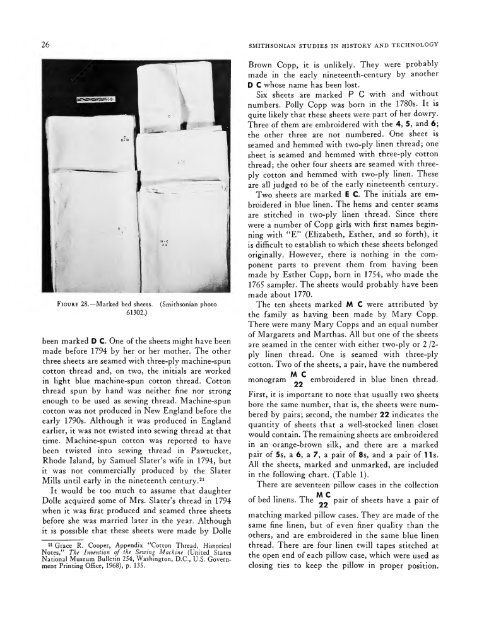The Copp Family Textiles - Smithsonian Institution Libraries
The Copp Family Textiles - Smithsonian Institution Libraries
The Copp Family Textiles - Smithsonian Institution Libraries
Create successful ePaper yourself
Turn your PDF publications into a flip-book with our unique Google optimized e-Paper software.
26 SMITHSONIAN STUDIES IN HISTORY AND TECHNOLOGY<br />
FIGURE 28.—Marked bed sheets. (<strong>Smithsonian</strong> photo<br />
61302.)<br />
been marked D C. One of the sheets might have been<br />
made before 1794 by her or her mother. <strong>The</strong> other<br />
three sheets are seamed with three-ply machine-spun<br />
cotton thread and, on two, the initials are worked<br />
in light blue machine-spun cotton thread. Cotton<br />
thread spun by hand was neither fine nor strong<br />
enough to be used as sewing thread. Machine-spun<br />
cotton was not produced in New England before the<br />
early 1790s. Although it was produced in England<br />
earlier, it was not twisted into sewing thread at that<br />
time. Machine-spun cotton was reported to have<br />
been twisted into sewing thread in Pawtucket,<br />
Rhode Island, by Samuel Slater's wife in 1794, but<br />
it was not commercially produced by the Slater<br />
Mills until early in the nineteenth century. 21<br />
It would be too much to assume that daughter<br />
Dolle acquired some of Mrs. Slater's thread in 1794<br />
when it was first produced and seamed three sheets<br />
before she was married later in the year. Although<br />
it is possible that these sheets were made by Dolle<br />
21 Grace R. Cooper, Appendix "Cotton Thread, Historical<br />
Notes," <strong>The</strong> Invention of the Sewing Machine (United States<br />
National Museum Bulletin 254, Washington, D.C, U.S. Government<br />
Printing Office, 1968), p. 135.<br />
Brown <strong>Copp</strong>, it is unlikely. <strong>The</strong>y were probably<br />
made in the early nineteenth-century by another<br />
D C whose name has been lost.<br />
Six sheets are marked P C with and without<br />
numbers. Polly <strong>Copp</strong> was born in the 1780s. It is<br />
quite likely that these sheets were part of her dowry.<br />
Three of them are embroidered with the 4, 5, and 6;<br />
the other three are not numbered. One sheet is<br />
seamed and hemmed with two-ply linen thread; one<br />
sheet is seamed and hemmed with three-ply cotton<br />
thread; the other four sheets are seamed with threeply<br />
cotton and hemmed with two-ply linen. <strong>The</strong>se<br />
are all judged to be of the early nineteenth century.<br />
Two sheets are marked E C. <strong>The</strong> initials are embroidered<br />
in blue linen. <strong>The</strong> hems and center seams<br />
are stitched in two-ply linen thread. Since there<br />
were a number of <strong>Copp</strong> girls with first names beginning<br />
with "E" (Elizabeth, Esther, and so forth), it<br />
is difficult to establish to which these sheets belonged<br />
originally. However, there is nothing in the component<br />
parts to prevent them from having been<br />
made by Esther <strong>Copp</strong>, born in 1754, who made the<br />
1765 sampler. <strong>The</strong> sheets would probably have been<br />
made about 1770.<br />
<strong>The</strong> ten sheets marked M C were attributed by<br />
the family as having been made by Mary <strong>Copp</strong>.<br />
<strong>The</strong>re were many Mary <strong>Copp</strong>s and an equal number<br />
of Margarets and Marthas. All but one of the sheets<br />
are seamed in the center with either two-ply or 2 /2ply<br />
linen thread. One is seamed with three-ply<br />
cotton. Two of the sheets, a pair, have the numbered<br />
M C<br />
embroidered in blue linen thread.<br />
monogram 22<br />
First, it is important to note that usually two sheets<br />
bore the same number, that is, the sheets were numbered<br />
by pairs; second, the number 22 indicates the<br />
quantity of sheets that a well-stocked linen closet<br />
would contain. <strong>The</strong> remaining sheets are embroidered<br />
in an orange-brown silk, and there are a marked<br />
pair of 5s, a 6, a 7, a pair of 8s, and a pair of lis.<br />
All the sheets, marked and unmarked, are included<br />
in the following chart. (Table 1).<br />
<strong>The</strong>re are seventeen pillow cases in the collection<br />
M C .<br />
of bed linens. <strong>The</strong> pair of sheets have a pair of<br />
matching marked pillow cases. <strong>The</strong>y are made of the<br />
same fine linen, but of even finer quality than the<br />
others, and are embroidered in the same blue linen<br />
thread. <strong>The</strong>re are four linen twill tapes stitched at<br />
the open end of each pillow case, which were used as<br />
closing ties to keep the pillow in proper position.

















